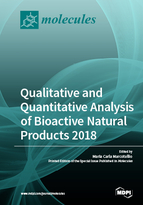Qualitative and Quantitative Analysis of Bioactive Natural Products 2018
A special issue of Molecules (ISSN 1420-3049). This special issue belongs to the section "Natural Products Chemistry".
Deadline for manuscript submissions: closed (31 October 2018) | Viewed by 151176
Special Issue Editor
Interests: plant extract analysis; bioactive natural compounds; natural product isolation and characterization; NMR spectroscopy
Special Issues, Collections and Topics in MDPI journals
Special Issue Information
Dear Colleagues,
Natural products are a rich source of novel biologically/pharmacologically-active compounds. Due to their high structural diversity and complexity, they represent interesting structural scaffolds that can offer promsing candidates for the study of biologically-active source of new drugs, functional foods and food additives. In recent years, great effort has been devoted to the quali- and quantitative analysis of plant extracts and bioactive metabolites.
This Special Issue welcomes original research and reviews of literature on all aspects of the analysis of plant extracts and bioactive compounds.
Prof. Dr. Maria Carla Marcotullio
Guest Editor
Manuscript Submission Information
Manuscripts should be submitted online at www.mdpi.com by registering and logging in to this website. Once you are registered, click here to go to the submission form. Manuscripts can be submitted until the deadline. All submissions that pass pre-check are peer-reviewed. Accepted papers will be published continuously in the journal (as soon as accepted) and will be listed together on the special issue website. Research articles, review articles as well as short communications are invited. For planned papers, a title and short abstract (about 100 words) can be sent to the Editorial Office for announcement on this website.
Submitted manuscripts should not have been published previously, nor be under consideration for publication elsewhere (except conference proceedings papers). All manuscripts are thoroughly refereed through a single-blind peer-review process. A guide for authors and other relevant information for submission of manuscripts is available on the Instructions for Authors page. Molecules is an international peer-reviewed open access semimonthly journal published by MDPI.
Please visit the Instructions for Authors page before submitting a manuscript. The Article Processing Charge (APC) for publication in this open access journal is 2700 CHF (Swiss Francs). Submitted papers should be well formatted and use good English. Authors may use MDPI's English editing service prior to publication or during author revisions.
Keywords
- Bioactive Natural Compounds
- Qualitative and Quantitative Extract Analysis
- Conventional and Non-Conventional Analytical Techniques
- UV/Vis spectroscopy
- NMR spectroscopy
- Mass spectrometry







